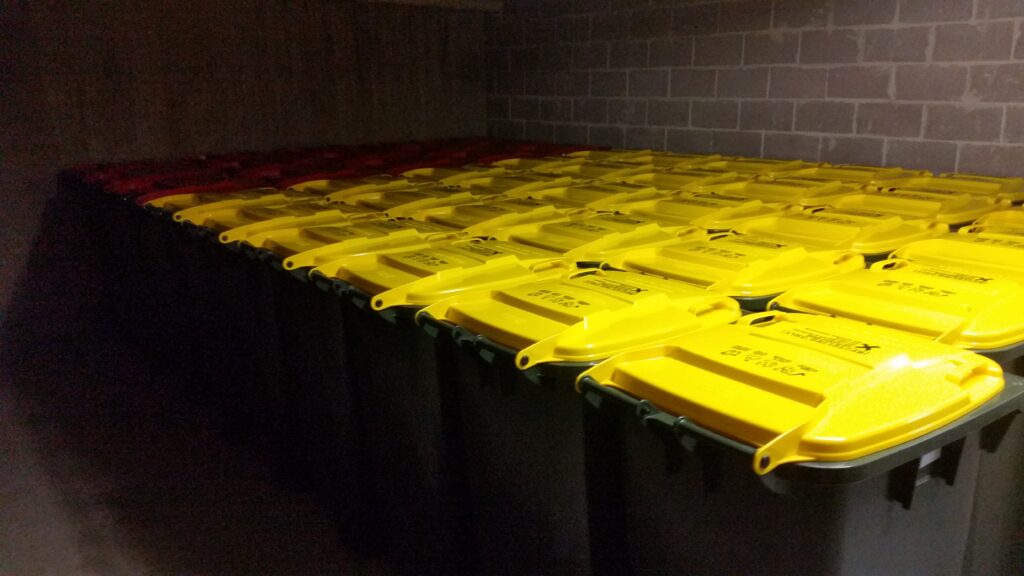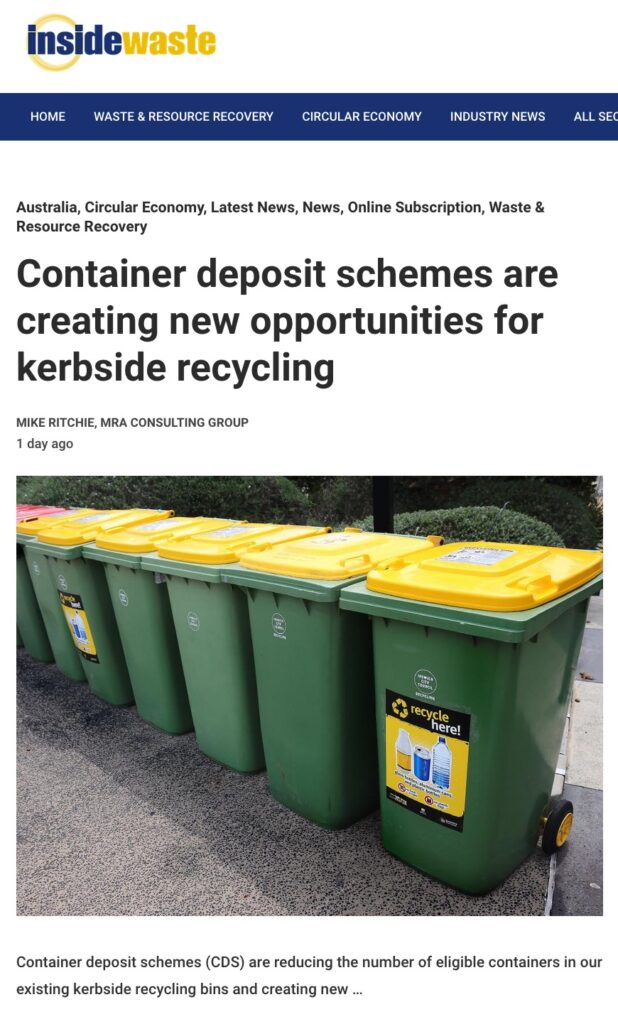Container deposit schemes are creating new opportunities for kerbside recycling
By: Mike Ritchie, MRA Consulting Group

Container deposit schemes (CDS) are reducing the number of eligible containers in our existing kerbside recycling bins and creating new opportunities for recycling through the nation’s yellow lid recycling bins.
Before CDS, eligible containers represented about 50% of the volume of most kerbside bins in Australia. As more containers are recovered through reverse vending machines and drop off systems, they are freeing up valuable “real estate” in the yellow top bins.
Most Councils have seen a fall in eligible containers of around 50% freeing up at least 30% of the 240 litre yellow top bins.
That creates opportunities for new products to go into the yellow bin system. But what?
Well first we should ask ‘what is going into the yellow bins now?’ The best data set for this is from NSW.
There are 127 Councils providing waste services in NSW and of these 110 offer kerbside recycling (yellow lid bins). There are 17 reasonably remote Councils that do not yet offer kerbside recycling.
[It is worth pointing out that only 17% of what a household generates is kerbside recycling (packaging containers, cardboard and newsprint). Organics are 55% and the remaining 28% is true residual. Unfortunately, most of the organics still goes to landfill. So my advice to those 17 Councils that have not yet provided a yellow lid bin is don’t rush. Provide a FOGO bin first and create local jobs in composting instead.]
But I digress.
Paper and cardboard, glass, aluminium and steel cans and plastic containers 1-3 (PET, HDPE and PVC) are accepted in almost all of the existing kerbside services across NSW (108/110 services).
But at that point we start to see inconsistency, especially for plastic.
- 97 Councils allow LDPE
- 99 Polypropylene
- 83 Polystyrene
- 84 allow “other plastic”
- 34 Councils allow plant pots and hard plastics
- 13 allow plastic bags and other film plastic.
(With this level of variation in acceptability criteria, is it any surprise that residents get confused?)
- 91 Councils allow Liquid Paper Board containers as part of paper.
At this point consistency really falls apart.
- 6 Councils allow single use batteries in the yellow recycling bin
- 5 allow electrical goods (toasters, etc)
- 3 allow clothes and other textiles
- 4 allow a miscellany of other stuff.
The first thing to say is surely we could agree to limit kerbside recycling to an agreed group of products. The Australian Council of Recycling has proposed exactly that. ‘Project Yellow’ suggests it should be a simple and common list.
The second thing to say is that additional ‘virtue’ (often known as “wishcycling’) by a few Councils to allow batteries, e-waste or plastic bags, does almost nothing to Australia’s recycling rates but it increases confusion significantly. Every time a household moves or goes on holidays, they bring their recycling habits with them. That explains part of Australia’s imbedded 10% recycling contamination rate.
The third thing to say is the batteries and e-waste are now the subject of specific Extended Producer Responsibility schemes (EPR) and therefore collection and recycling should be paid for by the producers and manufacturers. Put simply, if all Councils decided to include these products in recycling then they should be paid for it.
Fourth, Victoria is about to add another bin for glass. That creates more real estate opportunity but does not affect the mix of products accepted.
Which finally, brings us to the question of what should we add to the new yellow top bin real estate.
Let’s start with some principles. The main reasons we recycle are to:
- Capture the embodied energy of resources (reducing GHG emissions from virgin material processing)
- Return resources to the productive economy – saving money for producers and lowering economic costs
- Protecting limited resources (though most of the above are abundant)
- Reducing landfill consumption rates.
So in principle, we should start with products that have high embodied energy or have high return value or are scarce (and therefore valuable).
They must also be capable of being collected and sorted efficiently and safely. That rules out things like batteries, smoke alarms and gas bottles. Rope and other stringy materials are anathema to MRF sorting equipment, so they are also out.
The most obvious candidates for me are:
- Pots and pans – high embodied energy, high material value (aluminium and steel).
- Anything that is the subject of an EPR scheme where the recycling system is paid to collect and return it. This includes e-waste but could include coffee pods, mobile phones etc where the producers are prepared to pay the MRFs additional money to recover their products. These would probably need to be returned in a dedicated non-breakable bag that could be recovered at the MRF.
- Clothing (in a bag) which can be recovered by the MRF. I have a client trialling this and it is going gangbusters.
- Plastic film (in a bag) but again only where the MRF is paid additionally by the plastic or retail industry to collect and recover it.
The bottom line is the system has to be common across Australia, have net economic or environmental benefits and be able to cover the additional cost of collection and sorting (compared to the opportunity cost of landfill).
That means it needs to be paid for by someone. It should not be left to the odd Council to try to innovate at the odd MRF. That just increases confusion and leaves the local Council picking up the bill. Wrong.
So until the National Recycling Minister (Trevor Evans) can herd the State Environment Ministers into agreements on EPR schemes, we should hasten cautiously in relation to expanding products in the yellow lid bin.
We should strip out all of the “wishcycling” listed above and limit ourselves to the major products – paper and cardboard (including LPB); plastics, glass, steel and aluminium containers. That is it for now. No plastic bags, no e-waste, no toasters until national systems are agreed and then we move as a nation. As one. Simple.
So Governments should fund trials of the above “candidates” and work with stakeholders to develop options, costings and a roadmap.
With the export ban rolling out now, I would have thought this was a priority.
I have proposed a “Council and MRF working group” within WMRR or ACOR to try to start this process. Let me know if there is interest.
This article has been published by the following media outlets:




